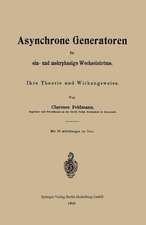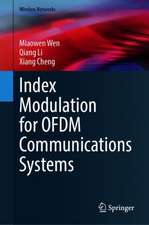Control of Electrical Drives: Power Systems
Autor Werner Leonharden Limba Engleză Paperback – 4 oct 2012
| Toate formatele și edițiile | Preț | Express |
|---|---|---|
| Paperback (1) | 582.97 lei 6-8 săpt. | |
| Springer Berlin, Heidelberg – 4 oct 2012 | 582.97 lei 6-8 săpt. | |
| Hardback (1) | 728.88 lei 6-8 săpt. | |
| Springer Berlin, Heidelberg – 10 aug 2001 | 728.88 lei 6-8 săpt. |
Din seria Power Systems
- 18%
 Preț: 937.05 lei
Preț: 937.05 lei - 18%
 Preț: 770.77 lei
Preț: 770.77 lei - 20%
 Preț: 1002.47 lei
Preț: 1002.47 lei - 18%
 Preț: 1004.60 lei
Preț: 1004.60 lei - 18%
 Preț: 882.49 lei
Preț: 882.49 lei - 18%
 Preț: 775.43 lei
Preț: 775.43 lei - 18%
 Preț: 721.90 lei
Preț: 721.90 lei - 18%
 Preț: 887.15 lei
Preț: 887.15 lei -
 Preț: 563.49 lei
Preț: 563.49 lei - 18%
 Preț: 938.97 lei
Preț: 938.97 lei - 18%
 Preț: 930.90 lei
Preț: 930.90 lei - 18%
 Preț: 934.49 lei
Preț: 934.49 lei - 18%
 Preț: 933.22 lei
Preț: 933.22 lei - 15%
 Preț: 631.05 lei
Preț: 631.05 lei - 18%
 Preț: 1097.42 lei
Preț: 1097.42 lei - 18%
 Preț: 944.88 lei
Preț: 944.88 lei - 18%
 Preț: 1362.75 lei
Preț: 1362.75 lei - 15%
 Preț: 628.82 lei
Preț: 628.82 lei - 15%
 Preț: 630.23 lei
Preț: 630.23 lei - 18%
 Preț: 2455.26 lei
Preț: 2455.26 lei - 18%
 Preț: 941.47 lei
Preț: 941.47 lei - 18%
 Preț: 1209.13 lei
Preț: 1209.13 lei - 15%
 Preț: 632.51 lei
Preț: 632.51 lei - 18%
 Preț: 940.95 lei
Preț: 940.95 lei - 18%
 Preț: 1210.68 lei
Preț: 1210.68 lei - 15%
 Preț: 686.54 lei
Preț: 686.54 lei - 18%
 Preț: 937.13 lei
Preț: 937.13 lei - 15%
 Preț: 630.09 lei
Preț: 630.09 lei - 15%
 Preț: 623.49 lei
Preț: 623.49 lei - 18%
 Preț: 938.97 lei
Preț: 938.97 lei - 18%
 Preț: 1220.76 lei
Preț: 1220.76 lei - 18%
 Preț: 936.02 lei
Preț: 936.02 lei - 18%
 Preț: 930.59 lei
Preț: 930.59 lei - 18%
 Preț: 945.64 lei
Preț: 945.64 lei - 18%
 Preț: 928.27 lei
Preț: 928.27 lei - 18%
 Preț: 1091.98 lei
Preț: 1091.98 lei - 15%
 Preț: 631.23 lei
Preț: 631.23 lei - 15%
 Preț: 625.41 lei
Preț: 625.41 lei - 18%
 Preț: 1096.02 lei
Preț: 1096.02 lei - 15%
 Preț: 629.13 lei
Preț: 629.13 lei - 18%
 Preț: 941.15 lei
Preț: 941.15 lei - 18%
 Preț: 1214.70 lei
Preț: 1214.70 lei - 18%
 Preț: 943.02 lei
Preț: 943.02 lei
Preț: 582.97 lei
Preț vechi: 685.85 lei
-15% Nou
Puncte Express: 874
Preț estimativ în valută:
111.57€ • 116.23$ • 92.76£
111.57€ • 116.23$ • 92.76£
Carte tipărită la comandă
Livrare economică 08-22 februarie 25
Preluare comenzi: 021 569.72.76
Specificații
ISBN-13: 9783642626098
ISBN-10: 3642626092
Pagini: 480
Ilustrații: XVIII, 460 p.
Dimensiuni: 155 x 235 x 25 mm
Greutate: 0.67 kg
Ediția:Softcover reprint of the original 3rd ed. 2001
Editura: Springer Berlin, Heidelberg
Colecția Springer
Seria Power Systems
Locul publicării:Berlin, Heidelberg, Germany
ISBN-10: 3642626092
Pagini: 480
Ilustrații: XVIII, 460 p.
Dimensiuni: 155 x 235 x 25 mm
Greutate: 0.67 kg
Ediția:Softcover reprint of the original 3rd ed. 2001
Editura: Springer Berlin, Heidelberg
Colecția Springer
Seria Power Systems
Locul publicării:Berlin, Heidelberg, Germany
Public țintă
GraduateCuprins
1. Elementary Principles of Mechanics.- 1.1 Newtons Law.- 1.2 Moment of Inertia.- 1.3 Effect of Gearing.- 1.4 Power and Energy.- 1.5 Experimental Determination of Inertia.- 2. Dynamics of a Mechanical Drive.- 2.1 Equations Describing the Motion of a Drive with Lumped Inertia.- 2.2 Two Axes Drive in Polar Coordinates.- 2.3 Steady State Characteristics of Motors and Loads.- 2.4 Stable and Unstable Operating Points.- 3. Integration of the Simplified Equation of Motion.- 3.1 Solution of the Linearised Equation.- 3.2 Analytical Solution of Nonlinear Differential Equation.- 3.3 Numerical and Graphical Integration.- 4. Thermal Effects in Electrical Machines.- 4.1 Power Losses and Temperature Restrictions.- 4.2 Heating of a Homogeneous Body.- 4.3 Different Modes of Operation.- 5. Separately Excited DC Machine.- 5.1 Introduction.- 5.2 Mathematical Model of the DC Machine.- 5.3 Steady State Characteristics with Armature and Field Control.- 5.4 Dynamic Behaviour of DC Motor with Constant Flux.- 6. DC Motor with Series Field Winding.- 6.1 Block Diagram of a Series-wound Motor.- 6.2 Steady State Characteristics.- 7. Control of a Separately Excited DC Machine.- 7.1 Introduction.- 7.2 Cascade Control of DC Motor in the Armature Control Region.- 7.3 Cascade Control of DC Motor in the Field-weakening Region.- 7.4 Supplying a DC Motor from a Rotating Generator.- 8. Static Converter as a Power Actuator for DC Drives.- 8.1 Electronic Switching Devices.- 8.2 Line-commutated Converter in Single-phase Bridge Connection.- 8.3 Line-commutated Converter in Three-phase Bridge Connection.- 8.4 Line-commutated Converters with Reduced Reactive Power.- 8.5 Control Loop Containing an Electronic Power Converter.- 9. Control of Converter-supplied DC Drives.- 9.1 DC Drive with Line-commutated Converter.-9.2 DC Drives with Force-commutated Converters.- 10. Symmetrical Three-Phase AC Machines.- 10.1 Mathematical Model of a General AC Machine.- 10.2 Induction Motor with Sinusoidal Symmetrical Voltages in Steady State.- 10.3 Induction Motor with Impressed Voltages of Arbitrary Wave- forms.- 10.4 Induction Motor with Unsymmetrical Line Voltages in Steady State.- 11. Power Supplies for Adjustable Speed AC Drives.- 11.1 Pulse width modulated (PWM) Voltage Source Transistor Converter (IGBT).- 11.2 Voltage Source PWM Thyristor Converter.- 11.3 Current Source Thyristor Converters.- 11.4 Converter Without DC Link (Cycloconverter).- 12. Control of Induction Motor Drives.- 12.1 Control of Induction Motor Based on Steady State Machine Model.- 12.2 Rotor Flux Orientated Control of Current-fed Induction Motor.- 12.2.1 Principle of Field Orientation.- 12.3 Control of Voltage-fed Induction Motor.- 12.4 Field Orientated Control of Induction Motor with a Current Source Converter.- 12.5 Control of an Induction Motor Without a Mechanical Sensor.- 12.6 Control of an Induction Motor Using a Combined Flux Model.- 13. Induction Motor Drive with Reduced Speed Range.- 13.1 Doubly-fed Induction Machine with Constant Stator Frequency and Field-orientated Rotor Current.- 13.2 Control of a Line-side Voltage Source Converter as a Reactive Power Compensator.- 13.3 Wound-Rotor Induction with Slip-Power Recovery.- 14. Variable Frequency Synchronous Motor Drives.- 14.1 Control of Synchronous Motors with PM Excitation.- 14.2 Synchronous Motor with Field- and Damper-Windings.- 14.3 Synchronous Motor with Load-commutated Inverter (LCI- Drive).- 15. Some Applications of Controlled Electrical Drives.- 15.1 Speed Controlled Drives.- 15.2 Lineax Position Control.- 15.3 Lineax Position Control with Moving Reference Point.- 15.4 Time-optimal Position Control with Fixed Reference Point.- 15.5 Time-optimal Position Control with Moving Reference Point.






















